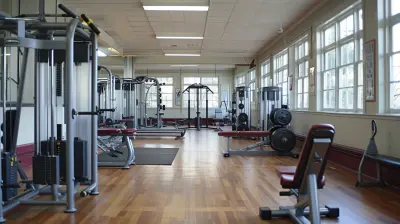The Science of Flexibility: Why Stretching Matters for Performance
4 June 2025
When was the last time you actually paid attention to your flexibility? If you're like most people, stretching is either an afterthought or something you only do when you're feeling stiff. But what if I told you that stretching is more than a simple warm-up or cooldown? In fact, it plays a huge role in athletic performance, injury prevention, and overall fitness.
So, let's dive into the science behind flexibility and why stretching should be a non-negotiable part of your routine. 
What is Flexibility?
Flexibility refers to the ability of your muscles and joints to move through their full range of motion (ROM). It’s what allows you to touch your toes, do a deep squat, or even just reach for something on a high shelf.But flexibility isn’t just about being able to bend and twist—it's about efficiency. The more flexible you are, the better your muscles and joints function, which directly impacts your movement, strength, and endurance. 
The Connection Between Flexibility and Performance
Athletes and fitness enthusiasts often focus on building strength and endurance, but flexibility deserves equal attention. Here’s why:1. Enhances Range of Motion
Greater flexibility means your muscles can extend further without resistance. This is crucial in sports like gymnastics, martial arts, or yoga, but it also benefits weightlifters, runners, and even casual exercisers.2. Reduces the Risk of Injuries
Tight muscles are more prone to strains, tears, and other injuries. When your body moves freely without restriction, you're less likely to overextend or exert excessive force on your joints and muscles.3. Improves Circulation
When you stretch, blood flow to your muscles increases, delivering oxygen and essential nutrients while flushing out metabolic waste. This results in better muscle recovery and reduced soreness.4. Increases Muscle Efficiency
Flexible muscles are more relaxed and require less energy to perform movement. This translates to better endurance and overall performance.5. Enhances Posture and Balance
Poor flexibility can lead to muscle imbalances, which affect posture and stability. Stretching helps correct these imbalances, keeping your body aligned and preventing long-term issues.
Types of Stretching: Which One is Best?
Not all stretches are created equal. Different types of stretching serve different purposes, and knowing which one to use at the right time can make a huge difference.1. Static Stretching
This involves holding a stretch for 15-60 seconds without movement. It’s best used post-workout to relax muscles and improve flexibility over time.Example: Holding a hamstring stretch while seated.
2. Dynamic Stretching
These are controlled, moving stretches that prepare the muscles for activity. They are best done before workouts to improve mobility and blood flow.Example: Leg swings or arm circles before a run.
3. Ballistic Stretching
A more advanced method where you use momentum to push your body beyond its normal range. It’s risky and usually reserved for professional athletes.Example: Bouncing to reach your toes.
4. PNF (Proprioceptive Neuromuscular Facilitation) Stretching
A technique that involves contracting and relaxing the muscle to achieve a deeper stretch. It’s commonly used in physical therapy.Example: Partner-assisted hamstring stretches. 
The Science Behind Stretching
Ever wondered what happens inside your muscles when you stretch? Here’s the physiological breakdown:1. Muscle Spindles and Golgi Tendon Organs
These are sensory receptors in your muscles that detect changes in length and tension. When you stretch, muscle spindles send signals to your brain to prevent overstretching, while the Golgi tendon organs respond by relaxing the muscle to allow a deeper stretch.2. Fascia and Flexibility
Your muscles are surrounded by connective tissue called fascia. When this tissue is tight, it limits movement. Stretching helps loosen the fascia, increasing flexibility.3. Neuromuscular Adaptations
Regular stretching trains your nervous system to tolerate and adapt to greater ranges of motion, making movements feel more natural and effortless.Common Flexibility Myths (Debunked!)
There’s a lot of misinformation surrounding flexibility and stretching. Let’s clear up some of the biggest myths.❌ Myth #1: Stretching Before Exercise Prevents Injuries
While warming up is essential, static stretching before a workout can actually reduce strength and performance. Instead, opt for dynamic stretches to prepare your muscles.❌ Myth #2: You Have to Hold a Stretch for a Long Time
Holding a stretch for too long isn't always better. Shorter, consistent stretching sessions are more effective over time.❌ Myth #3: Stretching is Only for Athletes
Everyone—regardless of fitness level—can benefit from stretching. Whether you're lifting weights, running, or sitting at a desk all day, flexibility plays a key role in overall well-being.❌ Myth #4: If You're Not Naturally Flexible, You’ll Never Be
Flexibility isn’t just genetic. With consistent effort, anyone can improve their range of motion and mobility.How to Incorporate Stretching Into Your Routine
Flexibility training doesn’t need to be complicated. Here’s an easy way to make it a regular habit:1. Warm-Up with Dynamic Stretching
Before diving into your workout, spend 5-10 minutes doing dynamic stretches to get your muscles ready.2. Stretch Post-Workout
Once you’re finished exercising, use static stretching to cool down and enhance recovery.3. Set a Dedicated Stretching Day
Just like strength training or cardio, schedule a day for deep stretching or yoga to maintain flexibility.4. Listen to Your Body
Never push into pain. Stretching should feel like a gentle pull, not unbearable discomfort.5. Stay Consistent
Flexibility takes time. Aim for at least 10-15 minutes of stretching daily for noticeable improvements.Final Thoughts
Stretching is often overlooked, but it’s a powerful tool for enhancing performance, preventing injuries, and improving overall movement. Whether you're an athlete, a gym-goer, or just someone looking to stay active, incorporating flexibility work into your routine can make a world of difference.So, the next time you think about skipping your stretch, remember—your body will thank you for it!
all images in this post were generated using AI tools
Category:
Sports ScienceAuthor:

Frankie Bailey
Discussion
rate this article
2 comments
Rex McBride
Flexibility isn't optional; it’s a performance powerhouse. Ignoring stretching is like neglecting fuel for a race car. If you want to unlock your true athletic potential, embrace flexibility—there's no excuse for being stiff and underperforming!
June 17, 2025 at 3:32 AM

Frankie Bailey
Absolutely! Flexibility is key to maximizing performance and preventing injury. Embracing a regular stretching routine truly unlocks your athletic potential. Thank you for highlighting this vital aspect!
Natalie Carrillo
Great article! It’s fascinating how flexibility impacts overall performance. I appreciate the insights on stretching techniques—it’s a crucial aspect often overlooked in athletic training. Keep up the good work!
June 13, 2025 at 11:54 AM

Frankie Bailey
Thank you for your kind words! I’m glad you found the insights on flexibility and stretching techniques helpful. Your support means a lot!


